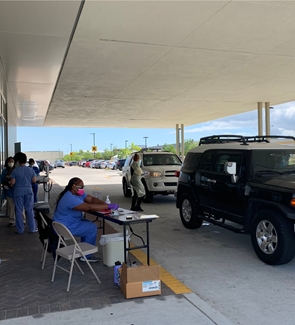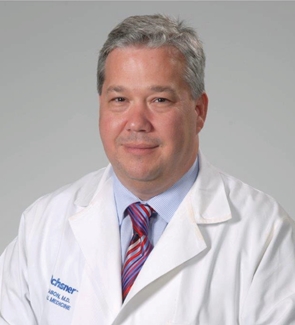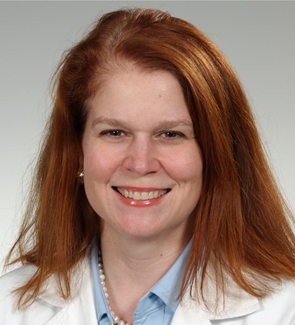Watch an Instagram Live interview with Dana H. Smetherman, MD, MPH, MBA, FACR.
In early 2020, Pedro Cazabon, MD, primary care service line leader at Ochsner Health System, intently watched news that was coming out of Asia related to the emerging COVID-19 pandemic. Little did he know that his community in New Orleans was facing an approaching storm, one that would put him and his primary care colleagues on the front lines of fighting a public health crisis in one of the early hot spots in the U.S.
“As with everybody around the world, we were watching a crisis unfold in Asia, which seemed so far removed from us here in the U.S. at the time,” says Cazabon. “Then all of a sudden, it flared in Washington and then New Orleans and all of the initial hot spots — and a frenzy started to happen because COVID-19 is a new disease on the planet. It doesn’t behave like other viruses in its class. Some people were saying it will be nothing; it’s a cold or the flu. But then patients started showing up in our emergency room and the intensive care unit (ICU) — many with terrible outcomes. And we knew it was dire.”

Thanks to radiology’s guidance, care providers at Ochsner Medical Center avoided using chest CT imaging inappropriately as a means to test for COVID-19. |
He continues, “Our doctors were scared. Our staff was scared. We had personal protective equipment (PPE) shortages. We had no testing in place at that time. We really didn’t know what this novel disease was. Almost every doctor, one by one, encountered some variant that made us realize we had lost our so-called eyeball test — the ability to use our training and experience to arrive at a reasonable diagnosis at a glance. It was strange to have a disease that shows up all of a sudden, and you don’t have your basic skillset to diagnose. So, we started scrambling for answers.”
Luckily for Cazabon and his colleagues, Ochsner Medical Center has a remarkable radiology team — led by Dana H. Smetherman, MD, MPH, MBA, FACR — that had some of the answers and was ready to collaborate with care providers to guide them through the early stages of the pandemic and beyond. More importantly, the radiology team had already forged strong working partnerships with their clinical colleagues, so they were a go-to resource for knowledge in the midst of crisis.
Leveraging a collaborative approach to patient care and proven communications tools, Ochsner Medical Center, with radiology helping to lead the way, battled back against a flaring COVID-19 outbreak in New Orleans and positioned the health system to respond effectively to the evolving public health crisis.
Counting on Colleagues
As COVID-19 started to spread rapidly in the U.S. and virus testing lagged, many medical providers began to express an interest in using chest radiographs or CT exams to screen and diagnose patients with suspected or known COVID-19 infection. Cazabon and his primary care colleagues were among those wondering if radiology could help fill the knowledge gap.
“Without testing, we were grappling for answers,” says Cazabon. “We had heard that the chest imaging could tell the story; it might be a fast path to diagnosis. So, I immediately picked up the phone and called Dana Smetherman, who is chair of our radiology department and with whom I already had a strong clinical partnership, and asked, ‘Is this something we can do?’ She immediately said ‘no, no, no.’ In a 10-minute conversation, she explained why not and provided additional guidance to help us go forward with safe imaging practices. In primary care, that was our first COVID-19-related collaboration with radiology, and we’ve had many more since.”
Smetherman notes that ACR guidance on the issue was clear: CT should not be used to screen for or as a first-line test to diagnose COVID-19. To date, viral testing remains the only specific method of diagnosis. (Read the
ACR Statement on Use of Computed Tomography (CT) and Radiography for Suspected COVID-19 Infection.)

Pedro Cazabon, MD, primary care service line leader at Ochsner Health System, counted on strong relationships with radiology to guide pandemic response. |
Safety of staff and patients was also top of mind for Smetherman. “Not only is CT an inappropriate way to test for COVID-19, but it also potentially exposes your team to the disease because chest scans can take a while, and patients have to inhale and exhale while the technologists are in close proximity,” says Smetherman. “We are doing everything possible to keep our teams safe, and that means extra focus on appropriate and necessary imaging.”
Looking back, Cazabon says that having a good working relationship between the leader of radiology and the leaders of the clinical teams saved a lot of wasted time and avoided unnecessary imaging studies. “Without that partnership, I might have quickly said, ‘If we can’t get testing, then everybody with symptoms gets a quick chest CT as the clearance.’ We would have ordered thousands of chest CTs to manage in the short term — out of sheer desperation. But I trust Dana, and if she says no, then it’s no.”
He adds, “To me it is a great example of a radiology leader working together with a primary care leader and steering away from suboptimal patient management. It drives home the point that you need good, strong working relationships established ahead of a crisis, so when you need to call on that expertise and knowledge, you already have that trust built in and you can quickly respond and do the right thing for your patients.”
Ramping Up Safe Imaging
After the conversation with Cazabon, Smetherman, who is also associate medical director of medical specialties at Ochsner, quickly realized that other care providers throughout the health system were likely raising the same questions. So, she collaborated with departmental leaders to get the word out to frontline care teams, like emergency and primary care, and emphasized that they should not use CT as a backdoor way to get a COVID-19 test. Smetherman and her colleagues also worked to establish a process to ensure safe imaging for patients who needed it.

As radiology chair, Dana H. Smetherman, MD, MPH, MBA, FACR, leveraged communication tools and a collaborative approach to patient care to battle an emerging public health crisis. |
“We agreed that we would separate patients with symptoms and those without symptoms into distinct imaging suites,” says Cazabon. “We decided we would set up one chest X-ray station for patients with a cough and other COVID-19 symptoms, and we ensured that staff took extra precautions. We designated another X-ray suite for patients with other imaging needs. So, we were able to get our X-rays done expeditiously and without exposing all of the people in the radiology suite to patients who we suspected had COVID-19.”
As part of the patient-handling process, Cazabon says they also created a program called Red Dot, modeled after an approach used during flu season in which anybody with cold and flu symptoms gets a colored dot on their chart. “With possible COVID-19 patients who we were sending for imaging or to the lab, we realized we needed to do a warm handoff to transfer care from one department to another,” he says. “That way providers are able to see the red dot in the chart and be aware it is a person of concern coming into the department. That handoff process became very important, especially during the times when we didn’t have enough masks and PPE for our staff and patients.” (To learn more about how Ochsner handled safe imaging in a pandemic hot zone, read the Imaging 3.0 case study “
Overcoming Adversity.”)
Going Virtual
At the peak of the crisis in New Orleans, providers at Ochsner Medical Center also realized they had a critical tool at their disposal to help stop the spread of the virus: technology. The health system had been talking about ramping up virtual visits and telehealth consults for several years, but the COVID-19 outbreak accelerated adoption almost over-night.
According to Cazabon, the primary care department remained open to patients who needed immediate care. “During the crisis, more than 80% of our visits went virtual,” he says. “We were able to stand up a virtual network in a week. In 2019, Ochsner only conducted about 2,500 virtual visits the entire year, and now we do almost that number every day. Using technology to connect with our patients and care for them in their homes — without exposing them or our team to potential infection — makes all the difference.”
Cazabon says that the medical community responds well to real-world challenges. “When faced with a true threat, we pull together quickly and get things going in no time. When something moves from the theoretical to the real, all of a sudden, we can mobilize the things we’ve been talking about or thinking about doing into action. The potential was always there to do virtual visits; it just wasn’t real enough. Now, everybody says, ‘I love these virtual visits; we should have been doing them for years.’ That’s one of the things we won’t give back after this is over. It will be one of the good outcomes from this crisis.”
Leveraging Technology
As a radiologist who has been using technology for decades, Smetherman embraces the use of integrated tools to communicate with her colleagues. “It used to be radiologists were the only ones sitting in front of a workstation,” she says. “Now our referring providers are also using electronic health records (EHR) on a more regular basis. We’ve found it incredibly helpful to use the communication tools within the EHR because our clinical colleagues are also on it all of the time, which speeds our responsiveness. I used to have to call providers to collaborate. I’ve got tons of people’s cell phone numbers, and I know the backdoor numbers for a lot of the clinics. It’s been a pleasant surprise how quickly we can now respond when we use our own EHR. And, it’s a tool that has been sitting right here all this time.”
Cazabon agrees, “Whether a radiologist is at home or in the reading room, it all plays the same for us. Last week, I sent a patient with a twisted ankle over for an X-ray. Within 20 minutes, it was already read and the findings sent back to me before the patient even got back to our office. I have no idea where the radiologist was, but we communicated about everything electronically. We also use secure chat in the EHR, which has been fabulous because you can send a message using an app on your phone and get an immediate response without needing to text someone’s personal phone or wait until they pick up a message.”
Stephen I. Johnson, MD, staff radiologist, section head of the ultrasound department at Ochsner, agrees that leveraging technology to open the lines of communication between radiology and ordering physicians has been one of the positive outcomes of the pandemic. “Before, I didn’t have the secure chat capability on my phone, so I would only see messages and queries from providers when I logged into my workstation, which was often hours after my colleagues needed help,” he says. “Now, I see it on my phone immediately, so it makes me more responsive.”
.jpg?h=325&w=295&hash=FE58AF2FA68F2C2CB9CE8FA654F10A0D)
Stephen I. Johnson, MD, ultrasound section head, says that remote workstations and secure chat capabilities enabled radiologists to be highly responsive to referrers. |
To drive home the point, Johnson offers a a before-and-after scenario. “Let’s say I read a CT study ordered by our emergency department (ED); I’m happy with it and I sign off. Then the physician has a question, so he messages me. Prior to secure chat, I wouldn’t have seen the message until I signed back in the next morning. Now, I get notified on my phone and can quickly respond. That saves the ED doctor a whole lot of time and trouble because, otherwise, he would’ve had to get to another radiologist to look at an exam he or she hadn’t read. With secure chat, we avoid that whole situation. It takes me a minute to answer the question when it would have taken that physician and the radiologist a half hour. That kind of seamless response speaks volumes about radiology’s ability to be a key partner in patient care.”
Forging Partnerships
Close cooperation among specialties is critical at all times to deliver the best patient care — but it is especially vital during times of a rapidly escalating public health crisis. That’s when strong, collaborative partnerships like the ones forged at Ochsner really pay off.
“This pandemic highlighted the importance of cooperation and mutual respect,” says Cazabon. “Dana and I have collaborated on projects over the years, so we could count on that trusted relationship when we needed it most. If you don’t have cooperation at the leadership level, then you won’t have cooperation five steps down. You need to forge those partnerships between radiology and other clinical areas before you need them. That’s what we’ve done here at Ochsner, and it helped us meet this crisis head on and deliver better care for our patients.”



.jpg?h=325&w=295&hash=FE58AF2FA68F2C2CB9CE8FA654F10A0D)

